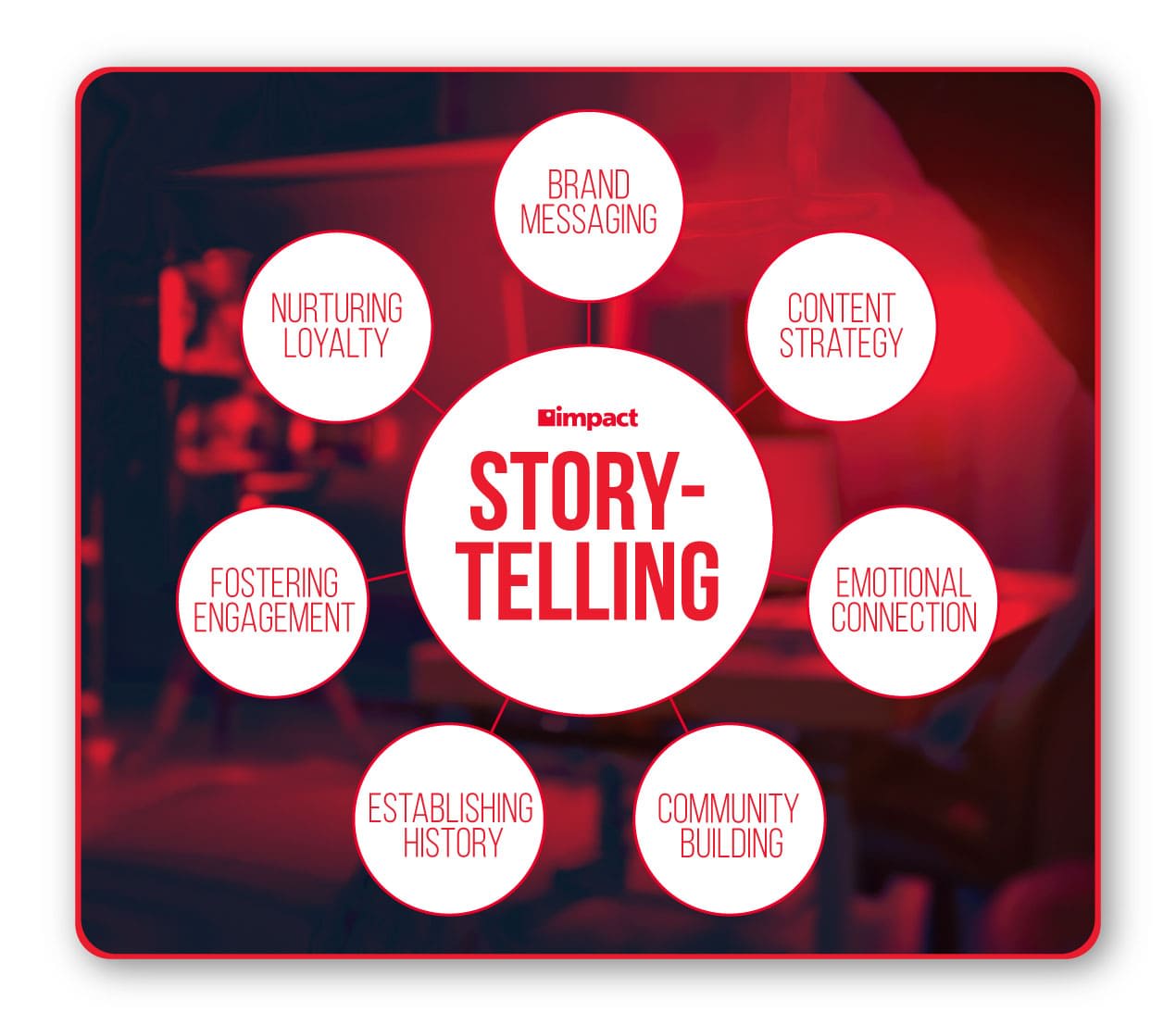Certain stories are so compelling that they stand the test of time, continuing to resonate with new audiences decades and even centuries later like the masterworks by Shakespeare, Jane Austen, or Edgar Allan Poe, for example. In the same vein, powerful brand storytelling fosters a deeper connection with your audience, emphasizes what makes you unique, and ultimately makes your brand more relatable.
In our world of social media and online content, it’s more important than ever to have strong core messaging that underpins all of your marketing efforts. Every initiative can be linked back to a throughline that enhances the pull of your story overall.
Let’s explore how companies today are leveraging powerful brand storytelling to create deeper connections with their targeted audience and foster a loyal and invested consumer base.
For a deeper look into brand awareness strategies specifically, take a few to watch Impact’s webinar, Brand Awareness Strategies Blueprint.
The Gravity of a Good Story
A good story will captivate your audience, nurture emotional investment, and create a lasting impression. Establishing such a deep connection with your audience is integral in winning the attention of consumers and fostering customer loyalty.
Whether you’re telling the story of your company's founding, or creating lore around a new product or service launch, your brand can use storytelling devices to generate additional interest and higher rates of engagement. When telling the story of your company’s founding, for instance, you’ll be more relatable if you detail the challenges faced on the journey in addition to the successes.
An excellent example of using powerful brand storytelling can be found in Patagonia. The major outdoor retailer started as a one-man shop whose main mission wasn’t selling equipment, but rather creating better mountain climbing equipment that wouldn’t deface the mountains he so loved climbing. It is truly one of the most compelling stories in modern business and demonstrates the power of a good story.
On top of detailing relatable challenges, brands can also use humor in their storytelling to further foster engagement and create community by letting readers in on the joke. Using literary devices in your brand storytelling will only make your messaging more compelling and drive audience buy-in.
At the end of the day, a good story will make your audience care, and if they care about your story, they care about your brand.
Identifying Core Messaging
The first step in identifying the core messaging of your brand is to conduct a thorough audit. This involves analyzing the brand’s history, mission, values, and current market positioning. It's essential to understand the brand’s unique value proposition, its target audience, and the emotional triggers that resonate with them.
This phase often includes stakeholder interviews, customer surveys, and competitive analysis to gather comprehensive insights into what makes the brand unique and relevant.
Next, distill these insights into a clear and compelling brand narrative. This narrative should encapsulate your essence and differentiate it from competitors. It involves defining the brand’s purpose (why it exists beyond making a profit), its vision (what it aspires to achieve), and its mission (how it plans to achieve its vision).
The narrative should be authentic, aligning with the brand’s core values and promises. It's about finding the human element in the brand’s story—what makes it relatable and emotionally engaging.
With the narrative established, it’s time to craft key messages that form the backbone of all brand communications. These messages should be concise, memorable, and adaptable across various channels and formats. This messaging needs to reflect the brand narrative and resonate with the target audience.
It's about telling a consistent story that reinforces the brand's identity and values in every touchpoint. Ensure that the core messaging is not only clear and compelling but also flexible enough to adapt to different contexts and channels without losing its essence.
Crafting the Brand Voice
Once the core messaging has been identified, crafting a brand voice that is unique, engaging, and authentic involves translating these messages into a consistent and compelling communication style.
The first step is to revisit the brand's core messaging to ensure that the voice aligns perfectly with the brand's mission, values, and vision. This alignment ensures that the voice will consistently reinforce the brand's identity across all touchpoints.
The next step is to define the brand’s personality traits that will inform the voice. This involves selecting specific characteristics such as being friendly, authoritative, humorous, or inspiring. These traits should reflect the brand’s core messages and resonate with the target audience.
For example, a tech startup focusing on innovation and cutting-edge solutions might adopt a forward-thinking, enthusiastic, and slightly edgy voice. A luxury brand, on the other hand, might choose a more sophisticated, elegant, and refined voice.
Consider Dior, for instance. The luxury fashion house has their entire history documented in detail on their website, starting with the birth of Christian Dior in 1905. They use the brands long-standing history and high reputation to gain emotional investment from their audience.
A brand like Nike, however, leans on the stories of athletes, underdogs, and appeals to the fierce competitor within to garner that same investment from the user with different messaging.
Developing detailed voice guidelines is crucial for maintaining consistency. These guidelines should outline the tone, language style, and vocabulary that align with the brand’s personality. They should include specific examples and scenarios to illustrate how the voice should be used in various contexts, such as social media posts, customer service interactions, advertising campaigns, and website content.
Finally, it’s important to test and refine the brand voice. This involves gathering feedback from both internal stakeholders and the target audience to assess the efficacy of the voice in conveying the brand’s core messages and engaging the audience. By continuously refining the voice, brands can maintain a strong and engaging presence.
Key Elements of Brand Storytelling
With core messaging and the brand voice defined, let’s explore three key elements to consider in brand storytelling: the narrative arc, the emotional connection, and authenticity.
- Narrative Arc: The narrative arc is the structure that shapes the brand's story, making it engaging and memorable. A compelling narrative typically includes a clear beginning, middle, and end.
The beginning sets the stage by introducing the brand, its mission, and the challenges it aims to address. The middle delves into the journey, highlighting obstacles, turning points, and the brand’s determination. And the end provides resolution, showcasing the outcomes and the impact the brand has made.
This structure helps to create a coherent and engaging story that captures the audience's attention and keeps them invested.
- Emotional Connection: Creating an emotional connection is crucial for effective brand storytelling. Emotional stories resonate more deeply with audiences, making the brand more relatable and memorable. This involves identifying and tapping into the emotions that align with the brand’s core messaging and values.
For instance, a brand that promotes sustainability might share stories of individuals or communities positively impacted by their eco-friendly initiatives. By highlighting real-life experiences and emotions, the brand can foster a deeper connection with its audience, encouraging loyalty and advocacy.
- Authenticity: Authenticity is vital for building trust and credibility through brand storytelling. Audiences are increasingly discerning and can easily detect inauthentic or exaggerated stories. Therefore, it’s essential to be truthful and transparent in the narratives shared.
Authentic storytelling involves sharing genuine experiences, acknowledging challenges, and being honest about the brand’s journey and values. This could include behind-the-scenes insights, stories of failure and recovery, or testimonials from real customers.
Authentic stories not only enhance credibility but also foster a stronger emotional bond with the audience, as they feel they are engaging with a genuine and trustworthy brand.
By focusing on these key elements—narrative arc, emotional connection, and authenticity—brands can craft powerful stories that resonate with their audience, reinforce their core messaging, and strengthen their overall brand identity.
Wrapping Up on Brand Storytelling
With the volume of brand exposure that consumers are subject to today, it’s difficult for companies to stand out from the crowd. This is especially the case for start-ups and newer businesses that are just getting off the ground. This is where brand storytelling can really make a difference in your marketing strategies.
With powerful brand storytelling that’s engaging, authentic, and memorable, you’ll have a better chance at connecting with your audience, making a lasting impression, and winning a larger market share. After all, your story is going to communicate your biggest ideas and dreams to the world.
And remember, if they care about your story, they care about your brand.
If you want to learn more about building brand awareness and expanding the reach of your marketing efforts, check out Impact’s webinar, Brand Awareness Strategies Blueprint.




